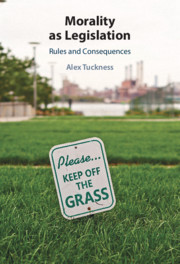Book contents
- Morality as Legislation
- Morality as Legislation
- Copyright page
- Dedication
- Contents
- Acknowledgments
- Abbreviations with Method of Citation
- Introduction
- Part I The Emergence of the Rule-Consequentialist Paradox
- Chapter 1 God and Consequences
- Chapter 2 Legislators, Architects, and Spectators
- Chapter 3 The Great Divide
- Chapter 4 Moral Expression as Legislation
- Chapter 5 Secular Heterodoxy
- Part II Contemporary Approaches to the Rule-Consequentialist Paradox
- Works Cited
- Index
Chapter 5 - Secular Heterodoxy
Twentieth-Century Rule-Utilitarianism
from Part I - The Emergence of the Rule-Consequentialist Paradox
Published online by Cambridge University Press: 29 July 2021
- Morality as Legislation
- Morality as Legislation
- Copyright page
- Dedication
- Contents
- Acknowledgments
- Abbreviations with Method of Citation
- Introduction
- Part I The Emergence of the Rule-Consequentialist Paradox
- Chapter 1 God and Consequences
- Chapter 2 Legislators, Architects, and Spectators
- Chapter 3 The Great Divide
- Chapter 4 Moral Expression as Legislation
- Chapter 5 Secular Heterodoxy
- Part II Contemporary Approaches to the Rule-Consequentialist Paradox
- Works Cited
- Index
Summary
In the twentieth century, secular philosophers explicitly defended rule-utilitarian theories as alternatives to act-utilitarian theories that, they believed, led to implausible moral conclusions. This approach was powerfully criticized by people like David Lyons and J. J. C. Smart who thought rule-consequentialism was paradoxical because it awarded rules a weight that could not be justified on consequentialist grounds. In the mid- to late twentieth century there were philosophers who attempted to challenge the boundaries of utilitarian orthodoxy by expressly using nonconsequentialist moral premises to justify the shift to a legislative rather than situated perspective. The focus on the failure of rule-utilitarianism in terms of strict utilitarian orthodoxy has obscured the importance of hybrid theories that draw on both consequentialist and nonconsequentialist premises. A number of thinkers who are classified as rule-utilitarians (and sometimes criticized for betraying utilitarian orthodoxy) in fact expressly acknowledged nonutilitarian aspects to their theories (including R. M. Hare and John Harsanyi). The chapter ends with a summary of the main historical claims of Part I.
- Type
- Chapter
- Information
- Morality as LegislationRules and Consequences, pp. 126 - 156Publisher: Cambridge University PressPrint publication year: 2021

